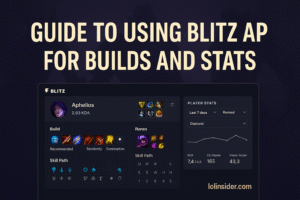Advanced ADC Guide: Kiting and Orb Walking is a must-read for anyone who wants to maximize their impact as an Attack Damage Carry in League of Legends. Kiting and orb walking are not just flashy mechanical tricks—they’re the backbone of consistent DPS, survival in teamfights, and the difference between carrying or being carried. Whether you’re a Bronze player trying to understand the basics of stutter stepping or a Diamond ADC perfecting micro-optimizations, this guide breaks down every concept step by step.
In this 3,500+ word guide, you’ll learn the theory, execution, and application of kiting and orb walking, with practical drills, champion examples, and matchup insights.
1. What Is Kiting?
Kiting is the technique of attacking while maintaining maximum possible distance from your opponent. In League of Legends, this means auto-attacking, then moving backward or sideways before your next auto attack, effectively “dragging” your enemy while still dealing consistent damage. The term comes from “flying a kite,” as you keep an opponent chasing without letting them close the gap.
Kiting allows ADCs to survive against assassins and bruisers, maximize their range advantage, and avoid unnecessary damage while still outputting DPS.
2. What Is Orb Walking?
Orb walking is the executional mechanic that enables kiting. It refers to cancelling your attack animation’s “backswing” so you can move immediately after your auto projectile fires.
The name comes from early RTS games like Warcraft 3, where units could attack, cancel, and move fluidly. In League, orb walking means stutter stepping between attacks—clicking to attack, then immediately issuing a move command, then attacking again as soon as your auto attack cooldown resets.
3. Why Kiting and Orb Walking Matter for ADCs
- Survivability: ADCs are fragile; kiting buys time and space.
- Max DPS: Standing still wastes time; orb walking keeps you efficient.
- Outplay Potential: With proper spacing, you can beat assassins, duelists, and even kite tanks.
- Teamfight Presence: A well-kiting ADC is the backbone of consistent DPS in fights.
4. The Mechanics of Auto Attacks
To master kiting, you must understand the anatomy of an auto attack:
- Wind-Up Time (Attack Cast Time): The brief moment after issuing an attack command before the projectile or melee swing connects.
- Projectile Travel (for ranged): The time it takes for the shot to reach the target.
- Backswing: The animation after your attack lands—this is cancelable.
- Cooldown: Your champion’s attack speed governs how soon you can attack again.
5. Attack Animation Breakdown
Every ADC has slightly different auto attack animations. For example:
- Caitlyn: Long wind-up but clear projectile.
- Jhin: Distinct rhythm due to reload mechanic.
- Kai’Sa: Fast animation that scales well with attack speed.
Knowing these timings lets you kite smoother and predict windows of vulnerability.
6. Input Buffering and Attack Cancelling
The secret to clean orb walking is cancelling the backswing. As soon as your projectile leaves, issue a move command. This shaves off wasted milliseconds and lets you reposition without losing DPS.
Input buffering ensures your next attack is queued immediately when it’s available, keeping your stutter step consistent.
7. Kiting Techniques for Beginners
- Right-Click Spam: Attack, then move back, repeat.
- Attack Move Command (A + Click): Ensures you don’t misclick minions.
- Step-by-Step Practice: Focus on fluid movement between autos.
8. Orb Walking at an Advanced Level
Advanced orb walking incorporates:
- Attack Move on Cursor vs Attack Move on Champion: Choosing which attack move setting suits your micro.
- Weaving Auto Attacks with Abilities: For example, weaving Lucian’s passive doubles into autos.
- Animation Cancels: Resetting attack timers with items like Galeforce or abilities like Tristana’s Explosive Charge.
9. Kiting in Different Game Phases
- Lane Phase: Kite melee champs when they try to last hit.
- Mid Game: Use kiting to reposition in skirmishes.
- Late Game: Kiting tanks and bruisers is your ultimate test—keep moving while outputting DPS.
10. ADC Champion Examples and Case Studies
- Vayne: The queen of kiting. Tumble cancels animations and maximizes orb walking.
- Kiting a Darius: Auto, move back, auto, sidestep his pull.
- Kiting an Irelia: Space carefully, orb walk while avoiding her dash resets.
11. Itemization and Its Effect on Kiting
- Galeforce: Offers a dash for extra spacing.
- Kraken Slayer: Maximizes DPS during extended kites.
- Phantom Dancer: Provides mobility and smoother orb walking.
- Boots of Swiftness: Great for repositioning.
12. Mouse and Keyboard Settings for Precision
- Attack Move on Cursor recommended for most ADCs.
- Low Mouse DPI (800–1200) for precise clicks.
- Quick Cast Abilities to minimize delay.
13. Common Mistakes Players Make
- Standing Still: Losing DPS time.
- Over-Kiting: Canceling autos too early.
- Clicking Too Far: Moving out of range.
- Ignoring Spacing: Walking into melee range unnecessarily.
14. Pro Player Insights and How They Kite
Watch pros like Ruler, Gumayusi, or Uzi:
- They kite perfectly without dropping DPS.
- They reposition constantly.
- They maximize spacing vs melee.
Studying their replays with slowed playback reveals their orb walking precision.
15. Training Drills to Master Kiting and Orb Walking
- Practice Tool Drill 1: Kite jungle camps while taking minimal damage.
- Drill 2: Spawn a dummy and practice orb walking around it in circles.
- Drill 3: 1v1 bots to practice stutter step under pressure.
16. Applying Kiting in Lane Phase
- Harass melee champions with autos.
- Orb walk to avoid minion aggro.
- Space carefully vs skillshots while attacking.
17. Applying Kiting in Mid and Late Game
- In teamfights, kite back toward your support.
- Always attack the closest threat while orb walking backward.
- Position around objectives to zone melee initiators.
18. ADC vs Melee: The Art of Spacing
- Keep at max range.
- Use attack move to avoid misclicks.
- Never give free engages.
19. ADC vs Ranged: Micro Footsies
Against ranged ADCs:
- Orb walk aggressively forward.
- Stutter step between minions.
- Force trades with superior mechanics.
20. How Ping and FPS Affect Kiting
- High ping delays your cancel timings—compensate with earlier inputs.
- Low FPS disrupts input buffering—optimize PC settings for smooth gameplay.
21. Conclusion: Becoming a True Marksman
Kiting and orb walking separate average ADCs from exceptional ones. By mastering input timing, spacing, and champion-specific mechanics, you can maximize DPS while staying alive.
Consistency is the ultimate goal: when kiting becomes muscle memory, you’ll notice your win rate climb, your dueling confidence grow, and your ability to carry teamfights improve.
Mastering kiting and orb walking doesn’t happen overnight—but with practice, you’ll join the ranks of true marksmen in League of Legends.







